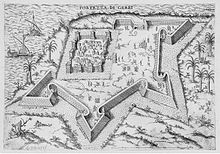Borj El Kebir
Borj El Kebir , also known as Borj El Ghazi Mustafa , in German "Great Castle", is the name of the largest, best-preserved fortifications on Djerba . It is one of the most visited historical sites on the island. The castle complex is located north of Houmt Essouk , not far from the fishing port.
history
The castle was built at the end of the 14th century over the ruins of the ancient Roman city of Griba, after the deportation of the soldier Alfonso V from Aragon on the orders of the Hafsid sultan from Tunisia . The first expansion of the facility followed in 1450.
The name Borj El Ghazi Mustafa comes from the Kaid who settled on Djerba in 1559 .
The Ottoman corsair leader Dragut had the fortress expanded around 1550 in order to be able to better protect himself from the retaliatory actions of the Christian seafarers (mainly Spaniards). In 1560, however, they sought the decision and appeared with a fleet of 30 ships and 30,000 men in front of Houmt Souk. They conquered the fortress very quickly and left a crew of 5,000 men behind, but on the way back Dragut and his fleet attacked the retreating Spaniards and Maltese and defeated them in the sea battle of Djerba , in which 18,000 men lost their lives. The fortress, which was still occupied, was besieged and after the occupation surrendered, the last man was beheaded. As a deterrent, the corsair leader had their heads piled up in a pyramid . This macabre symbol was seen for almost 300 years. In 1848, at the urging of the European powers, it was removed and an obelisk was erected in its place near the fortress.
During the period of French occupation, French troops camped in the castle from July 28, 1881 after they had invaded the island.
In 1903 the castle became the property of the Tunisian authorities. It was granted national historical monument status on March 15, 1904, and was converted into a museum. An extensive restoration has been taking place since 1968. Inside there are exhibits from different eras.
There are two mausoleums in the monument: Sidi Saad and Ghazi Mustafa, after the Bey of the same name.
gallery
literature
- Baedeker Tunisia. 3. Edition. 1995
Individual evidence
- ↑ Borj El Kebir. Retrieved September 4, 2017 .
- ↑ ↑ Kamel Tmarzizet, Djerba, l'île des rêves, Tunis, Société tunisienne des arts graphiques: ↑ Kamel Tmarzizet, Djerba, l'île des rêves, Tunis, Société tunisienne des arts graphiques, 1997, p. 140 .
- ↑ ↑ Éternelle Djerba, Tunis, Association de sauvegarde de l'île de Djerba et Société tunisienne des arts graphiques: ↑ Éternelle Djerba, Tunis, Association de sauvegarde de l'île de Djerba et Société tunisienne des arts graphiques, 1998, p. 21 .
Coordinates: 33 ° 52 ′ 55 ″ N , 10 ° 51 ′ 44 ″ E









